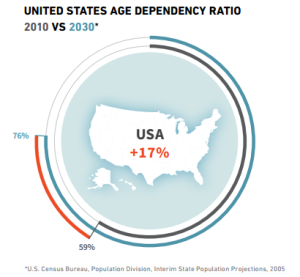ExcelinEd releases Turn and Face the Strain: Age Demographic Change and the Near Future of American Education
The myth that bigger budgets will lead to better public education has been refuted by years of research, yet a state’s commitment to quality schools often is measured by how much it spends on them.
That approach not only has failed but also is no longer sustainable given the demographic trends facing our nation. The coming crisis is detailed in a groundbreaking report out today from the Foundation for Excellence in Education and the Friedman Foundation for Educational Choice, Turn and Face the Strain: Age Demographic Change and the Near Future of American Education by Dr. Matthew Ladner.
The number of Baby Boomers entering retirement has been well documented. As they leave the workforce, their contributions to government revenues will decline while their demands on government expenditures will increase. We tend to focus on the impact this will have on services, entitlement programs and public employee pension funds. But as Dr. Ladner points out, there also will be a very real impact on our public education system because the growing number of retirees is accompanied by a second demographic phenomenon – the growing number of school-age children.
Sandwiched between the young and old is a shrinking percentage of workers that must provide for both their needs. They are becoming the rope in an unprecedented demographic tug-of-war because there is only so much wealth they can create. States will be forced to juggle competing demands with limited resources.
The inevitable result will be a retreat from the pay-more model of public education, replaced by models that are more efficient and more effective at preparing all children for a college or career. The latter is critical. Our children confront the most competitive global economy in world history. It is an economy that prioritizes knowledge and skills, yet international assessments in math and science show American students steadily losing ground to students in other countries in these subjects.
That trend must be reversed if America is to maintain its prosperity and its leadership role in the 21st century. We must do so quickly, cost-effectively and by all means possible. This means actively reforming policies that deal with teacher quality, governance, finance, digital learning and accountability. We must set expectations for students at a level that will prepare them for the challenges ahead.
 An obvious priority is customizing education in a way that empowers parents with a marketplace of education choices, allowing parents to pick the best options for their children. The resulting competition will improve results and incentivize cost savings.
An obvious priority is customizing education in a way that empowers parents with a marketplace of education choices, allowing parents to pick the best options for their children. The resulting competition will improve results and incentivize cost savings.
There already is choice for families that can afford private school tuition or to live in neighborhoods with top public schools. The parents denied choice are the ones whose incomes don’t allow them such privileges. And so it’s hardly surprising that their children attend the most ineffective schools and lag far behind their more affluent peers in reading, math and science.
The achievement gap that has bedeviled our education system for so long is in large part an opportunity gap. School choice is an argument for education equality.
And as you will see in Dr. Ladner’s report, it also is an argument for confronting the economic challenges ahead. Business as usual no longer is an option that states can afford.
Turn and Face the Strain: Age Demographic Change and the Near Future of American Education was developed through a partnership between the Foundation for Excellence in Education and the Friedman Foundation for Educational Choice, two of the foremost leaders in education reform policy and research.

